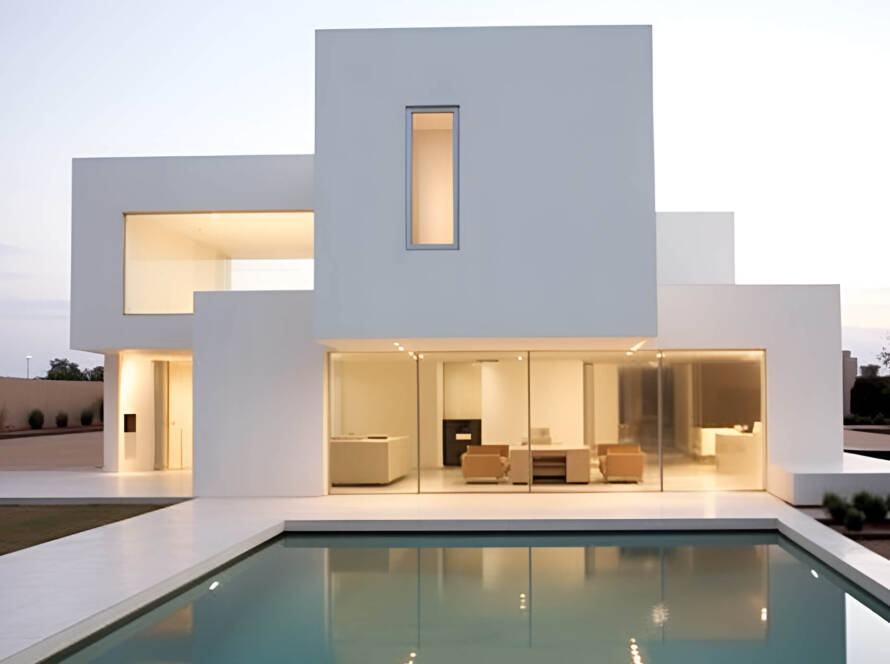High-tech architecture, also known as Structural Expressionism, emphasizes transparency, technology, and innovation in design. It’s a style that celebrates the building’s structure and mechanical systems by showcasing them as part of the aesthetic. This approach demands specific materials that balance strength, flexibility, and visual impact. In this article, we’ll explore the key materials that define high-tech architecture and why they are essential to this futuristic style.
1. Steel: The Backbone of High-Tech Structures
Steel is one of the most critical materials in high-tech architecture. Its high strength-to-weight ratio makes it ideal for creating large spans, intricate frameworks, and exposed structural elements.
- Why it’s used: Steel allows architects to push boundaries in terms of scale and form. It can be used in prefabricated modules, supports, frames, and even in decorative mechanical elements.
- Visual impact: Its industrial look adds to the raw and engineered aesthetic that defines high-tech design.
2. Glass: Transparency and Light
Glass is extensively used in high-tech architecture to bring natural light into the structure and to emphasize transparency.
- Why it’s used: Large glass panels help blur the lines between the interior and exterior, enhancing openness and flow of light.
- Types used: High-performance glazing, double or triple-glazed units, and smart glass are common, often with solar control coatings or UV protection.
- Design benefit: Glass exposes the building’s skeleton, putting the structural and mechanical systems on full display—a signature of high-tech design.
3. Aluminum: Lightweight and Corrosion-Resistant
Aluminum is another essential material in high-tech architecture due to its versatility and sleek appearance.
- Applications: Used in cladding, window frames, curtain wall systems, and external panels.
- Advantages: It’s lightweight, corrosion-resistant, and recyclable, making it ideal for modern, sustainable architecture.
- Aesthetic: Its metallic sheen complements the industrial style and pairs well with glass and steel.
4. Concrete: Functional and Expressive
While high-tech architecture leans toward industrial materials, concrete plays a vital supporting role.
- Why it’s used: Concrete provides strength and mass for foundations and core elements.
- Usage: Often left exposed or formed with smooth, modern finishes.
- Effect: Exposed concrete surfaces create a clean and honest look, staying true to the high-tech ethos of showcasing materials as they are.
5. Composite and High-Performance Materials
As technology evolves, so does material science. High-tech architecture embraces advanced materials for performance and innovation.
- Examples: Carbon fiber, ETFE (ethylene tetrafluoroethylene), Kevlar, fiber-reinforced polymers.
- Uses: ETFE is popular in roofing systems like stadiums and atriums due to its light weight and flexibility. Carbon fiber is used for lightweight structural components.
- Innovation edge: These materials allow for cutting-edge designs that were once impossible due to limitations in weight, strength, or flexibility.
6. Visible Mechanical Systems and Modular Elements
An often-overlooked “material” in high-tech architecture is the visibility of systems—ducts, elevators, pipes, and structural joints.
- Design language: These are not hidden but featured prominently as part of the building’s visual identity.
- Examples: The Pompidou Centre in Paris or Lloyd’s Building in London—both have elevators and mechanical systems visibly placed on the exterior.
Final Thoughts: Materials as the Message
High-tech architecture doesn’t hide its skeleton—it celebrates it. Each material is chosen not just for function, but for how it contributes to the architectural language of honesty, technology, and structural clarity. As a 3D visualizer or architect working with this style, understanding these materials is essential to accurately reflect the vision of high-tech design in renders and real-world applications.
Whether you’re working on a concept in Unreal Engine 5 or planning a real-life build, choosing the right materials defines the success of your high-tech project.


1 Comment
Ashton Porter
Duis autem vel eum iriure dolor in hendrerit in vulputate velit esse molestie consequat, vel illum dolore eu feugiat nulla facilisis at vero eros et accumsan et iusto odio dignissim qui blandit praesent luptatum zzril delenit augue duis dolore tefe.